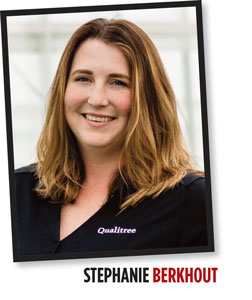5/1/2021
Under Pressure: Experiences With VPD
Stephanie Saccomano & Chris Knezetic

Back in the days of the “Old Normal” (2018), when the new greenhouse facility at the Qualitree main location was under construction, one of the many features we were excited to utilize was a high pressure fog system. We were keen to upgrade and begin environmentally controlling our propagation locations via Vapor Pressure Deficit (VPD) targets. Typically, we tent fresh-stuck unrooted cuttings (URCs) with plastic until the rooting stage. We then transition with cloth for a period of time, depending on the crop, prior to full exposure. By effectively implementing a VPD-reliant environment, we would ideally be eliminating some serious labor and crop management headaches.
To put this into perspective, two full propagation bays would typically use approximately 1,000 linear feet of 10-ft. wide plastic. Not only do these materials carry a cost, but working around the tent frames for tasks such as spraying and trimming is clumsy and time-consuming. But when first learning about the concept of VPD and how it could benefit crop health, it’s easy to go down the rabbit hole full of curiosity and come out of it bewildered.
Okay, what exactly is it? The “quick” version is VPD works by comparing the humidity and water pressure in the air against the same within the plant, and then steering transpiration rates by using equipment such as our high-pressure fog system. In a propagation environment where we desire low transpiration, high-pressure fog allows us to increase the water pressure in the air without saturating the foliage of the cuttings. With high air pressure due to high relative humidity, the moisture within the URC will have a difficult time escaping. This is achieved by lower VPD targets. Think: Lower VPD setpoint = less of a deficit between the leaf moisture and the external environment!
For crops due to finish, transpiration for nutrient uptake is the goal. While a higher VPD target is ideal, proceed with caution! Too high of a setpoint will lead to the closing of stomata and some rather unhappy plants. Depending on your objective with the crop, you may tweak your targets to induce more stress, or keep things content and vegetative.
Our first attempt using the high-pressure fog system and relying on VPD setpoints resulted in a mixed bag of Cupressus production. We were eager to ditch the tent set-up we had come to rely upon. They were safe, though difficult to install and work around while the newly stuck cuttings camped below. We propagated a full chamber of two bays out in the open. A sobering lesson was learned; we ended up with a much higher fallout percentage than we’d ever like to see! The bay of URCs quickly exhibited disease patterns from being too wet and experienced too many climate swings. We needed to better understand the setpoints and adapt our other typical crop management strategies to fit specific crops in this new environment.
We also quickly learned that our water source for the fogging unit wasn’t ideal, as hard water deposits clogged the emitters. It was clear we were too hasty in our enthusiasm and our spirits dimmed because of this failure. What if this whole installation was for nothing?
For a time, we didn’t use or rely on the fogging system except for basic temperature control via evaporative cooling in the summer months. Eventually, after more research and learning from sensor responses by tinkering with setpoints, we trusted this system for transitioning out of propagation environments, even though it was capable of so much more.
Chris was determined to utilize this system to its full potential, and continued avidly researching. It took persuading on his part to sway the team into giving VPD another shot, to prove it to be a valuable tool outside of what we had relegated it to. It became a matter of trusting another bay of plants, in this case hydrangea, to Chris and allowing him to prove his claims.
Well, that he did! Within 24 hours, we saw a marked improvement in these plants. It was simply a matter of a few keystrokes in the Argus program to convince us on the merits of this method of growing. Chris got the green light to continue applying his knowledge, and since then, we’ve successfully transitioned propagation of four genera to full VPD, including Cupressus! We’re currently eagerly—and cautiously—testing other genera in the hopes of reducing plastic usage and improving crop performance.
The ultimate goal? No more tents, no more plastic and healthier plants. GT
Stephanie Saccomano is Indoor Spaces Lead Grower for Qualitree Propagators in Rosedale, British Columbia, Canada.
Chris Knezetic is the Propagation Grower for Qualitree Propagators in Chilliwack, British Columbia.